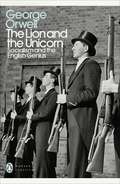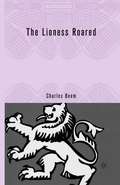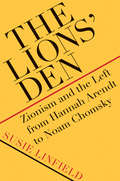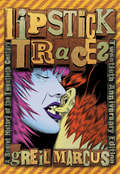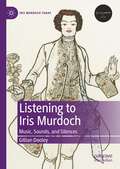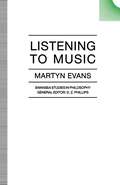- Table View
- List View
Links Between Beliefs and Cognitive Flexibility: Lessons Learned
by Jan Elen, Elmar Stahl, Rainer Bromme and Geraldine ClareboutWith the world and its structures becoming ever more complex, and the nature of future employment becoming ever more unpredictable, the notion of ‘cognitive flexibility’ has a high profile in educational and psychological debate. The contributions in this volume analyze the nature of cognitive flexibility, as well as the impact of different types of beliefs on cognitive flexibility. Making adequate decisions requires considering input from a variety of continuously evolving sources rather than adhering to predetermined procedures. Adopting a position in a debate necessitates the critical evaluation of different alternatives, while solving a problem entails selecting appropriate problem-solving strategies. Meanwhile, studying requires students to integrate a range of interventions, and treating a patient involves making a differential diagnosis. The common factor, cognitive flexibility, lies at the core of effective functioning in complex, domain-specific environments. Cognitive flexibility can be described as the disposition to consider diverse information elements while deciding on how to solve a problem or to execute a learning-related task in a variety of domains. The concept of ‘disposition’ implies that individuals will not always demonstrate cognitive flexibility even if they are in principle able to act in a cognitively flexible way. The notion does not require that alternatives are always deliberately considered, which is why this volume’s tandem discussion of beliefs is key element of the discussion. Beliefs play a central role in cognitive flexibility and relate to what individuals consider to be important, valid and/or true. Of specific interest is the relationship between epistemological beliefs and cognitive flexibility, especially as a particular subset of epistemological beliefs seems to be a prerequisite to a cognitively flexible disposition.
Links und rechts im Wandel: Zur Bedeutung und Relevanz der Richtungsbegriffe in Deutschland
by Philipp SchererPhilipp Scherer legt dar, wie sich die Begriffe links und rechts seit dem späten 18. Jahrhundert zu zentralen Ordnungskriterien in der Politik entwickelt haben und warum die Links-Rechts-Unterscheidung in Deutschland bis heute eine wichtige Kommunikations- und Orientierungshilfe innerhalb des politischen Raumes darstellt. Der Autor hebt hervor, dass insbesondere die semantische Anpassungsfähigkeit der Links-Rechts-Unterscheidung ihren langfristigen Erfolg bedingt. Anhand von Zeitungskommentaren werden die Veränderungen in der inhaltlichen Bedeutung von links und rechts in Deutschland zwischen 1949 und 2013 analysiert und die Auswirkungen dieses Wandels auf die gesellschaftliche Relevanz der Richtungsunterscheidung diskutiert.
Linksextremismus in Deutschland: Eine kritische Bestandsaufnahme
by Armin Pfahl-TraughberIn den 1970er und 1980er Jahren kam der Entwicklung des Linksextremismus in der öffentlichen und wissenschaftlichen Wahrnehmung große Bedeutung zu. Angesichts eines höheren Gefahrenpotentials des islamistischen und rechten Extremismus schwand diese Aufmerksamkeit in den letzten Jahren. Indessen lassen sich nach wie vor einschlägige politische Bestrebungen – wenn auch mit anderer Bedeutung – ausmachen. Dieses Buch, das für die 2. Auflage aktualisiert wurde, versteht sich als kritische Bestandsaufnahme zum Linksextremismus in Deutschland: Es präsentiert die relevanten Informationen über Auffassungen und Handlungen und schätzt sie hinsichtlich bestimmter Aspekte und Gesichtspunkt ein. Dabei werden häufig politisch motivierte Dramatisierungen oder Verharmlosungen zugunsten einer differenzierten Sicht auf das Gefahrenpotential des Linksextremismus vermieden.
The Lion and the Unicorn: Gladstone vs Disraeli
by Richard AldousGladstone and Disraeli were the fiercest political rivals of the modern age. Their intense hatred was ideological and deeply personal. Victorian Britain ruled the oceans and vast territories 'on which the sun never set'. The vitriolic duel between Gladstone and Disraeli was nothing less than a battle to lead the richest and most powerful nation on earth.To Disraeli, his antagonist was an 'unprincipled maniac' characterised by an 'extraordinary mixture of envy, vindictiveness, hypocrisy and superstition'. For Gladstone, his rival was 'The Grand Corrupter' whose destruction he plotted 'day and night, week by week, month by month'. Victorians were electrified by the confrontation. No wonder that when Lewis Carroll's Through the Looking-Glass appeared in 1871, so many readers recognised the great adversaries as the warring lion and unicorn 'fighting for the crown'.Richard Aldous gives us the first modern telling of this dramatic story of an intense and momentous rivalry. His vivid narrative style - at turns powerful, witty, stirring and theatrical - breathes new life into a familiar, half-remembered tale that is pivotal in Britain's island history. The Lion and the Unicorn is a brilliant rethinking of the Gladstone and Disraeli story for a new generation. Richard Aldous confirms a perennial truth: in politics, everything is personal.
The Lion and the Unicorn: Socialism and the English Genius (Penguin Modern Classics)
by George OrwellGeorge Orwell's moving reflections on the English character and his passionate belief in the need for political change.The Lion and the Unicorn was written in London during the worst period of the blitz. It is vintage Orwell, a dynamic outline of his belief in socialism, patriotism and an English revolution. His fullest political statement, it has been described as 'one of the most moving and incisive portraits of the English character' and is as relevant now as it ever has been.
Lionel Trilling and Irving Howe: And Other Stories of Literary Friendship
by Edward AlexanderThis pioneering effort links history and personality, by pairing intellectual friends and foes, most notably Lionel Trilling and Irving Howe, but also Thomas Carlyle and John Stuart Mill, T.E. Lawrence and Bertrand Russell, and lesser known figures. The periods range from the early 1830s, when Carlyle and Mill discovered each other, to 1975, when Lionel Thrilling died and the relationship with Howe ended. The essay that gives this volume its title is also the most ambitious. Alexander examines Trilling and Howe in relation to one another, as well as their comparative reactions to the Holocaust. He explores their participation in the fierce disputes of the fifties over the relationship between literature and society, and their perspectives on the turmoil of the American sixties. The chapter on the friendships (and ex-friendships) of Carlyle and Mill, Lawrence and Russell, views their stories against the background of the modern conflict between reason and feeling, positivism and imagination. But Alexander avoids viewing each pair of friends as counterparts. Though relationships may have begun in adversity, they sometimes developed into friendships. As a young woman, George Eliot dismissed Jews as candidates for 'extermination', but her friendship with the Talmudic scholar Emanuel Deutsch changed her into one of the major Judeophiles of the Victorian period. And the quartet of Thomas Carlyle, J. S. Mill, D. H. Lawrence and Bertrand Russell shows how quickly-formed literary friendships, especially those based on the hunger for disciples, sometimes dissolve into ex-friendships. This volume reveals new perspectives on leading literary figures and their relationships, and shows how personal friendship influences art.
Lionel Trilling and Irving Howe: And Other Stories of Literary Friendship
by Edward AlexanderThis pioneering effort links history and personality, by pairing intellectual friends and foes, most notably Lionel Trilling and Irving Howe, but also Thomas Carlyle and John Stuart Mill, T.E. Lawrence and Bertrand Russell, and lesser known figures. The periods range from the early 1830s, when Carlyle and Mill discovered each other, to 1975, when Lionel Thrilling died and the relationship with Howe ended. The essay that gives this volume its title is also the most ambitious. Alexander examines Trilling and Howe in relation to one another, as well as their comparative reactions to the Holocaust. He explores their participation in the fierce disputes of the fifties over the relationship between literature and society, and their perspectives on the turmoil of the American sixties. The chapter on the friendships (and ex-friendships) of Carlyle and Mill, Lawrence and Russell, views their stories against the background of the modern conflict between reason and feeling, positivism and imagination. But Alexander avoids viewing each pair of friends as counterparts. Though relationships may have begun in adversity, they sometimes developed into friendships. As a young woman, George Eliot dismissed Jews as candidates for 'extermination', but her friendship with the Talmudic scholar Emanuel Deutsch changed her into one of the major Judeophiles of the Victorian period. And the quartet of Thomas Carlyle, J. S. Mill, D. H. Lawrence and Bertrand Russell shows how quickly-formed literary friendships, especially those based on the hunger for disciples, sometimes dissolve into ex-friendships. This volume reveals new perspectives on leading literary figures and their relationships, and shows how personal friendship influences art.
The Lioness Roared: The Problems of Female Rule in English History (Queenship and Power)
by C. BeemCharles Beem uses Gender Studies and political and constitutional History to examine the problems faced by female rulers throughout British history, from the twelfth century Empress Matilda's imaginative efforts to become England's first regnant queen, to Queen Victoria's remarkable exercise of political power during the Bedchamber Crisis of 1839.
The Lions' Den: Zionism and the Left from Hannah Arendt to Noam Chomsky
by Susie LinfieldA lively intellectual history that explores how prominent midcentury public intellectuals approached Zionism and then the State of Israel itself and its conflicts with the Arab world In this lively intellectual history of the political Left, cultural critic Susie Linfield investigates how eight prominent twentieth-century intellectuals struggled with the philosophy of Zionism, and then with Israel and its conflicts with the Arab world. Constructed as a series of interrelated portraits that combine the personal and the political, the book includes philosophers, historians, journalists, and activists such as Hannah Arendt, Arthur Koestler, I. F. Stone, and Noam Chomsky. In their engagement with Zionism, these influential thinkers also wrestled with the twentieth century’s most crucial political dilemmas: socialism, nationalism, democracy, colonialism, terrorism, and anti†‘Semitism. In other words, in probing Zionism, they confronted the very nature of modernity and the often catastrophic histories of our time. By examining these leftist intellectuals, Linfield also seeks to understand how the contemporary Left has become focused on anti†‘Zionism and how Israel itself has moved rightward.
Lipstick Traces: A Secret History Of The Twentieth Century
by Greil MarcusThis is a secret history of modern times, told by way of what conventional history tries to exclude. Lipstick Traces tells a story as disruptive and compelling as the century itself.
Liquid Society and Its Law (Applied Legal Philosophy)
by Jiří PřibáňThis collection of essays brings together Zygmunt Bauman and a number of internationally distinguished legal scholars who examine the influence of Bauman's recent works on social theory of law and socio-legal studies. Contributors focus on the concept of 'liquid society' and its adoption by legal scholars. The volume opens with Bauman's analysis of fears and policing in 'liquid society' and continues by examining the social and legal theoretical context and implications of Bauman's theory.
Liquid Society and Its Law (Applied Legal Philosophy)
by Jiří PřibáňThis collection of essays brings together Zygmunt Bauman and a number of internationally distinguished legal scholars who examine the influence of Bauman's recent works on social theory of law and socio-legal studies. Contributors focus on the concept of 'liquid society' and its adoption by legal scholars. The volume opens with Bauman's analysis of fears and policing in 'liquid society' and continues by examining the social and legal theoretical context and implications of Bauman's theory.
Lise Meitner and the Dawn of the Nuclear Age
by Patricia RifeIn this captivating biography, Patricia Rife interprets both the life and times of Lise Meitner (1878-1968), the female physicist at the heart of the discovery of nuclear fission. She was a colleague and friend of many of the giants of 20th century physics: M. Planck, her Berlin mentor, A. Einstein, M. von Laue, Madame M. Curie, J. Chadwick, W. Pauli, and N. Bohr. Meitner was the first woman to earn a Ph.D. in physics at the University of Vienna, a pioneer in the research of radioactive processes and, together with her nephew Otto Robert Frisch, an interpreter of the process of nuclear fission in 1938. Yet at the end of World War II, her colleague of thirty years, radiochemist Otto Hahn alone was awarded the 1944 Nobel Prize in Chemistry for the "discovery" of nuclear fission -- a discovery based on years of research in which Meitner was directly involved before her secret escape from Nazi Germany.
A List of Successes That Can Change the World: Essays Dedicated to Philip Wadler on the Occasion of His 60th Birthday (Lecture Notes in Computer Science #9600)
by Sam Lindley Conor McBride Phil Trinder Don SannellaThis volume is published in Honor of Philip Wadler on the occasion of his 60th birthday, and the collection of papers form a Festschrift for him. The contributions are made by some of the many who know Phil and have been influenced by him. The research papers included here represent some of the areas in which Phil has been active, and the editors thank their colleagues for agreeing to contribute to this Festschrift. We attempt to summarize Phil Wadler's scientific achievements. In addition, we describe the personal style and enthusiasm that Phil has brought to the subject.
Listen: On Music, Sound and Us
by Michel FaberA curious book that will change your relationship with the heard world In Listen, Michel Faber's lifelong passion for music culminates in an intriguing exploration of two big questions: how we listen to music and why we listen to music. He muses on the notion of 'cool', delves into the rich lodes of commercial and aesthetic worth and interviews a panoply of people who experience music in different ways, unlocking some surprising answers.
Listening, Belonging, and Memory
by Abigail GardnerListening, Belonging, and Memory puts connected listening at the center of current debates around whose voices might be listened to, who by, and why. Arguing that listening has to be understood in relation to the self, nation, age, witnessing, and memory, it uses examples from digital storytelling, listening projects, and critical media analysis to highlight connections between listening and power. It centers on voices, stories, and silence, how they interweave, and are activated, maneuvered, reconfigured, and denied. It focuses on the small, microengagementsthat crouch within the superstructures of violent border control and the censorious policing of sonic citizenry, identifying cracks in the reshuffling of histories and hierarchies that connected listening affords.
Listening, Belonging, and Memory
by Abigail GardnerListening, Belonging, and Memory puts connected listening at the center of current debates around whose voices might be listened to, who by, and why. Arguing that listening has to be understood in relation to the self, nation, age, witnessing, and memory, it uses examples from digital storytelling, listening projects, and critical media analysis to highlight connections between listening and power. It centers on voices, stories, and silence, how they interweave, and are activated, maneuvered, reconfigured, and denied. It focuses on the small, microengagementsthat crouch within the superstructures of violent border control and the censorious policing of sonic citizenry, identifying cracks in the reshuffling of histories and hierarchies that connected listening affords.
Listening through the Noise: The Aesthetics of Experimental Electronic Music
by Joanna DemersContemporary electronic music has splintered into numerous genres and subgenres, all of which share a concern with whether sound, in itself, bears meaning. Listening through the Noise considers how the experience of listening to electronic music constitutes a departure from the expectations that have long governed music listening in the West.
Listening through the Noise: The Aesthetics of Experimental Electronic Music
by Joanna DemersContemporary electronic music has splintered into numerous genres and subgenres, all of which share a concern with whether sound, in itself, bears meaning. Listening through the Noise considers how the experience of listening to electronic music constitutes a departure from the expectations that have long governed music listening in the West.
Listening to Children: Being and becoming (Contesting Early Childhood)
by Bronwyn DaviesThrough a series of exquisite encounters with children, and through a lucid opening up of new aspects of poststructuralist theorizing, Bronwyn Davies opens up new ways of thinking about, and intra-acting with, children. This book carefully guides the reader through a wave of thought that turns the known into the unknown, and then slowly, carefully, makes new forms of thought comprehensible, opening, through all the senses, a deep understanding of our embeddedness in encounters with each other and with the material world. This book takes us into Reggio-Emilia-inspired Swedish preschools in Sweden, into the author’s own community in Australia, into poignant memories of childhood, and offers the reader insights into: new ways of thinking about children and their communities; the act of listening as emergent and alive; ourselves as mobile and multiple subjects; the importance of remaining open to the not-yet-known. Defining research as diffractive, and as experimental, Davies’ relationship to the teachers and pedagogues she worked with is one of co-experimentation. Her relationship with the children is one in which she explores the ways in which her own new thinking and being might emerge, even as old ways of thinking and being assert themselves and interfere with the unfolding of the new. She draws us into her ongoing experimentation, asking that we think hard, all the while delighting our senses with the poetry of her writing, and the stories of her encounters with children.
Listening to Children: Being and becoming (Contesting Early Childhood)
by Bronwyn DaviesThrough a series of exquisite encounters with children, and through a lucid opening up of new aspects of poststructuralist theorizing, Bronwyn Davies opens up new ways of thinking about, and intra-acting with, children. This book carefully guides the reader through a wave of thought that turns the known into the unknown, and then slowly, carefully, makes new forms of thought comprehensible, opening, through all the senses, a deep understanding of our embeddedness in encounters with each other and with the material world. This book takes us into Reggio-Emilia-inspired Swedish preschools in Sweden, into the author’s own community in Australia, into poignant memories of childhood, and offers the reader insights into: new ways of thinking about children and their communities; the act of listening as emergent and alive; ourselves as mobile and multiple subjects; the importance of remaining open to the not-yet-known. Defining research as diffractive, and as experimental, Davies’ relationship to the teachers and pedagogues she worked with is one of co-experimentation. Her relationship with the children is one in which she explores the ways in which her own new thinking and being might emerge, even as old ways of thinking and being assert themselves and interfere with the unfolding of the new. She draws us into her ongoing experimentation, asking that we think hard, all the while delighting our senses with the poetry of her writing, and the stories of her encounters with children.
Listening To Heloise: The Voice of a Twelfth-Century Woman (The New Middle Ages)
by NA NAHeloise, the twelfth-century French abbess and reformer, emerges from this book as one of history's most extraordinary women, a thinker-writer of profound insight and skill. Her supple and learned mind attracted the most radical philosopher of her time, Peter Abelard. He became her teacher, lover, husband, and finally monastic ally. That relationship has made her fame until now. But Heloise is far more important in her own right. Seventeen experts of international standing collaborate here to reveal and analyze how Heloise's daring achievements shaped normative issues of theology, rhetoric, rational argument, gender, and emotional authenticity. At last we are able to see her for herself, in her moment of history and human awareness.
Listening to Iris Murdoch: Music, Sounds, and Silences (Iris Murdoch Today)
by Gillian DooleyWhen we think of Iris Murdoch’s relationship with art forms, the visual arts come most readily to mind. However, music and other sounds are equally important. Soundscapes – music and other types of sound – contribute to the richly textured atmosphere and moral tenor of Murdoch’s novels. This book will help readers to appreciate anew the sensuous nature of Iris Murdoch’s prose, and to listen for all kinds of music, sounds and silences in her novels, opening up a new sub-field in Murdoch studies in line with the emerging field of Word and Music Studies. This study is supported by close readings of selected novels exemplifying the subtle variety of ways she deploys music, sounds and silence in her fiction. It also covers Murdoch’s knowledge of music and her allusions to music throughout her work, and includes a survey of musical settings of her words by various composers.
Listening to Music (Swansea Studies in Philosophy)
by Martyn EvansIn this book the author argues that human musical understanding is rooted in the traditions of culture and that experience of music depends crucially on what the individual brings to it.
Listening to Noise and Silence: Towards a Philosophy of Sound Art
by Salomé VoegelinListening to Noise and Silence engages with the emerging practice of sound art and the concurrent development of a discourse and theory of sound. In this original and challenging work, Salomé Voegelin immerses the reader in concepts of listening to sound artwork and the everyday acoustic environment, establishing an aesthetics and philosophy of sound and promoting the notion of a sonic sensibility. A multitude of sound works are discussed, by lesser known contemporary artists and composers (for example Curgenven, Gasson and Federer), historical figures in the field (Artaud, Feldman and Cage), and that of contemporary canonic artists such as Janet Cardiff, Bill Fontana, Bernard Parmegiani, and Merzbow.Informed by the ideas of Adorno, Merleau-Ponty and others, the book aims to come to a critique of sound art from its soundings rather than in relation to abstracted themes and pre-existing categories. Listening to Noise and Silence broadens the discussion surrounding sound art and opens up the field for others to follow.




